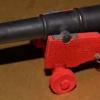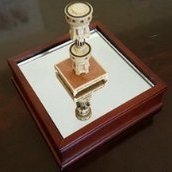-
Posts
3,084 -
Joined
-
Last visited
Reputation Activity
-
 Jaager got a reaction from Canute in Where to find 28 gauge black wire?
Jaager got a reaction from Canute in Where to find 28 gauge black wire?
If you have a draw plate with one wire gauge at the large end, you can draw the wire to any gauge that the plate has a hole for. It would be regular copper or brass wire since no coating will survive the process.
-
 Jaager got a reaction from EJ_L in Hammock Netting Question
Jaager got a reaction from EJ_L in Hammock Netting Question
Sometime between 1815 and 1861 the USN "suits" directed that the inner and outer surfaces of the hammock rails be wooden panels. They looked better because they could be painted. etc. It seems that the crews of ships did not favor this. This was a source of dangerous splinters when struck with a projectile. When the situation tended to the possibility of sure combat (an actual war), it seems that some captains replaced the wood with webbing and canvas. I am betting that "It is better to do and ask for forgiveness later, that ask for permission." is a Navy tradition that goes back far farther than we know.
-
 Jaager got a reaction from Chasseur in Scroll Saw question
Jaager got a reaction from Chasseur in Scroll Saw question
Sounds like you are pretty well set as far as tools are concerned.
As far as scratch -POF - the only real difference is the framing and any innards you add below the lowest gun deck.
An easy way to get into scratch is to replace kit components with those you make yourself.
If you get into heavy duty scratch and find that you want to harvest your own wood - an economical way would be to
make friends with someone who has a big band saw and use their facilities to get logs, braches and firewood into Byrnes saw sized billets.
All it will cost you is the band saw blades - they are not inexpensive and they break or get dull. The species of wood that we use is a lot tougher
on saw blades than what the average wood worker will use.
The greatest advantage in having the mill and lathe is that they are tools to make other tools.
Another tool that I use is a small drill press. The Eurotool DRL 300 works well for me- especially with a generic momentary power foot switch.
The mill will certainly double as a drill press and if you do not use that function all that often, the setup time saved by having a dedicated drill press will not be worth the expense.
As far as hand drills - I like the Dremel Model 8050 Rotary Tool - especially since they fixed the explode and burn problem. I just wish it "remembered" the last speed setting.
-
 Jaager got a reaction from Canute in sealing 1st planks to ready for 2nd planking??
Jaager got a reaction from Canute in sealing 1st planks to ready for 2nd planking??
The only reason I can think of to seal the first layer of planking in the two layer system would be if it was being used as a mold and the intention is to pop the 2nd layer off after it is formed. otherwise raw wood is optimal for the bond of the second layer. Better results may be had using yellow PVA - like Titebond II ( or Titebond III if you are compulsive). I read directions about a process to use yellow PVA as a contact adhesive by precoating and letting it dry - I forget what the step for bonding is and I can't find the reference. With planking - it being a fit-adjust - fit-adjust process, I see no advantage in instant bonding anyway.
I am compulsive about coating both surfaces - but for planking excess glue squeeze out is not a helpful thing so just completely wetting both surfaces lightly is the goal. For end grain to end grain - the bond will never be strong - but the way to get as strong a bond as possible would be to pre-wet both ends with the PVA - let it dry - and add more when gluing up. I made a miniature sponge stick glue applicator by gluing a round tooth pick to a small piece of foam packing. You can cut it just as wide as the plank and it will leave a just wet surface behind it.
-
 Jaager got a reaction from Mark P in Hull plank length
Jaager got a reaction from Mark P in Hull plank length
This is American from 1826 - HASN - General Instructions for building a Sloop of War
No length specified, but " No plank to be more than 12" wide at midships." I would think this would hold generally as a width max for any ship.
Deck plank Heart Pine "no more than 10" in width" "Average length to be 40'."
We had a lot more trees than France - and most were 1st growth. The pine was probably from the southeast US and the trees were 80-120 feet tall - mostly straight - and free of branches until near the top.
The White Oak could also be 80' tall - so long plank "could" be had - the wood is much heavier the effort in manipulating the logs probably constrained how long they cut the logs. Unlike deck planks, hull planks have curves and sometimes recurves. The spilling required with an especially long hull plank would probably involve more wasted wood than most builders would tolerate.
-
 Jaager got a reaction from thibaultron in Wood movement on ship hull
Jaager got a reaction from thibaultron in Wood movement on ship hull
Are you sure you want to use cypress? You might be happier using Hard Maple. It is more work for a cutting edge and a disk sander or table saw will burn the face if you are too aggressive. But it takes more work to overdo a cut, is much stronger, has a wonderful surface to finish and does not move so much with humidity changes.
-
 Jaager got a reaction from Canute in Hull plank length
Jaager got a reaction from Canute in Hull plank length
This is American from 1826 - HASN - General Instructions for building a Sloop of War
No length specified, but " No plank to be more than 12" wide at midships." I would think this would hold generally as a width max for any ship.
Deck plank Heart Pine "no more than 10" in width" "Average length to be 40'."
We had a lot more trees than France - and most were 1st growth. The pine was probably from the southeast US and the trees were 80-120 feet tall - mostly straight - and free of branches until near the top.
The White Oak could also be 80' tall - so long plank "could" be had - the wood is much heavier the effort in manipulating the logs probably constrained how long they cut the logs. Unlike deck planks, hull planks have curves and sometimes recurves. The spilling required with an especially long hull plank would probably involve more wasted wood than most builders would tolerate.
-
 Jaager got a reaction from mtaylor in Where to find 28 gauge black wire?
Jaager got a reaction from mtaylor in Where to find 28 gauge black wire?
If you have a draw plate with one wire gauge at the large end, you can draw the wire to any gauge that the plate has a hole for. It would be regular copper or brass wire since no coating will survive the process.
-
 Jaager got a reaction from EJ_L in Hull plank length
Jaager got a reaction from EJ_L in Hull plank length
This is American from 1826 - HASN - General Instructions for building a Sloop of War
No length specified, but " No plank to be more than 12" wide at midships." I would think this would hold generally as a width max for any ship.
Deck plank Heart Pine "no more than 10" in width" "Average length to be 40'."
We had a lot more trees than France - and most were 1st growth. The pine was probably from the southeast US and the trees were 80-120 feet tall - mostly straight - and free of branches until near the top.
The White Oak could also be 80' tall - so long plank "could" be had - the wood is much heavier the effort in manipulating the logs probably constrained how long they cut the logs. Unlike deck planks, hull planks have curves and sometimes recurves. The spilling required with an especially long hull plank would probably involve more wasted wood than most builders would tolerate.
-
 Jaager got a reaction from mtaylor in Hull plank length
Jaager got a reaction from mtaylor in Hull plank length
This is American from 1826 - HASN - General Instructions for building a Sloop of War
No length specified, but " No plank to be more than 12" wide at midships." I would think this would hold generally as a width max for any ship.
Deck plank Heart Pine "no more than 10" in width" "Average length to be 40'."
We had a lot more trees than France - and most were 1st growth. The pine was probably from the southeast US and the trees were 80-120 feet tall - mostly straight - and free of branches until near the top.
The White Oak could also be 80' tall - so long plank "could" be had - the wood is much heavier the effort in manipulating the logs probably constrained how long they cut the logs. Unlike deck planks, hull planks have curves and sometimes recurves. The spilling required with an especially long hull plank would probably involve more wasted wood than most builders would tolerate.
-
 Jaager got a reaction from Bill Hime in Scraping the hull with glass...
Jaager got a reaction from Bill Hime in Scraping the hull with glass...
The difference between sanding and scraping = sanding fills the pores on the surface with saw dust. scraping - they are open. This is important for violins and guitars - not sure about ship models.
I use single edge razor blades for deck scraping also.
A 5 inch wall scraper blade has uses. I recently made a handle for mine from a 1x 5x 5/16 piece of hardwood. Cut a slit for the blade and drilled a hole to match the one in the blade.
For heavier scraping, I have use a steel set sold by Lemuel Violins. It is 7 shapes and the size is right for 1:48 - 1:100 scale range.
https://www.violins.ca/tools/tools_cutting.html
-
 Jaager got a reaction from EJ_L in sealing 1st planks to ready for 2nd planking??
Jaager got a reaction from EJ_L in sealing 1st planks to ready for 2nd planking??
The only reason I can think of to seal the first layer of planking in the two layer system would be if it was being used as a mold and the intention is to pop the 2nd layer off after it is formed. otherwise raw wood is optimal for the bond of the second layer. Better results may be had using yellow PVA - like Titebond II ( or Titebond III if you are compulsive). I read directions about a process to use yellow PVA as a contact adhesive by precoating and letting it dry - I forget what the step for bonding is and I can't find the reference. With planking - it being a fit-adjust - fit-adjust process, I see no advantage in instant bonding anyway.
I am compulsive about coating both surfaces - but for planking excess glue squeeze out is not a helpful thing so just completely wetting both surfaces lightly is the goal. For end grain to end grain - the bond will never be strong - but the way to get as strong a bond as possible would be to pre-wet both ends with the PVA - let it dry - and add more when gluing up. I made a miniature sponge stick glue applicator by gluing a round tooth pick to a small piece of foam packing. You can cut it just as wide as the plank and it will leave a just wet surface behind it.
-
 Jaager got a reaction from Canute in First Boat
Jaager got a reaction from Canute in First Boat
Look higher up in the forum:
Member's Build Logs
Build Logs for SHIP MODEL KITS
Pinned 18th century English Longboat - by Chuck - c.1760
Your very kit - as done by the developer of the kit -
-
 Jaager got a reaction from WackoWolf in First Boat
Jaager got a reaction from WackoWolf in First Boat
Look higher up in the forum:
Member's Build Logs
Build Logs for SHIP MODEL KITS
Pinned 18th century English Longboat - by Chuck - c.1760
Your very kit - as done by the developer of the kit -
-
 Jaager got a reaction from mtaylor in First Boat
Jaager got a reaction from mtaylor in First Boat
Look higher up in the forum:
Member's Build Logs
Build Logs for SHIP MODEL KITS
Pinned 18th century English Longboat - by Chuck - c.1760
Your very kit - as done by the developer of the kit -
-
 Jaager got a reaction from Nirvana in Byrnes thickness sander vs Micro Mark's
Jaager got a reaction from Nirvana in Byrnes thickness sander vs Micro Mark's
Tom, if you use it a lot, with the Byrnes, you will make up the difference in sanding media cost in short order. WoodCraft has cloth backed media - wide variety of grits - sold by the yard - I have only paid attention to the 4" Klingspor, but they have Norton 3". Also, get the gum rubber shoe sole - sandpaper cleaning stick. Unclogs the grit.
-
 Jaager got a reaction from Canute in what wood to use for specifics....
Jaager got a reaction from Canute in what wood to use for specifics....
Apple -
For me - I would have it cut into 1"- 1 1/2 " slabs. Seal any cut ends - including branch knots - Parafin works, but so does a couple of thick coats of left over latex paint. Stack it somewhere protected - unheated attic works. Sticker the slabs = separate the slabs with 1/4 x 1/4 to 1/2 x 1/2 inch sticks to allow good air circulation around the whole plank. Should be dry in 12-18 months. If I was in a hurry, I would put my home made kiln back together and it would probably be dry in 2-3 months. All it is- a box made from foil faced 1 inch house foam insulating sheathing - heat source 200-300 W of incandescent light bulbs - their output is mostly IR- heat - and a surplus computer cooling fan to suck the water vapor out - Amazon has low cost fans - the tricky part for me - matching up the proper DC power supply. Nothing industrial - I just wanted the environment to be hotter than Blue Mold would like - since I was drying green Holly. Apple can be subject to fungus attack. The difference is that Blue Mold just discolors the wood - it is still just as strong - might even work as a Sun bleached decking material - for a deck that had not been holystoned, while the fungus that goes after Apple rots the wood.
Congrats on finding the wood. Make sure you get enough.
I do not have a jointer or a planer. Way back when, I tried to make do with a table saw - it worked to a point - would not buy one now - I discovered that a big band saw is better, more efficient and safer. I have a thickness sander that I made myself - at the time - the only way to have one. Now I would get a Byrnes thickness sander. An edger would be nice, but I made my own drum sanding table and added a fence to use it as an edger - the main problem is that I use a 1/6 HP motor - it is not powerful enough to take off much wood at a pass - it is fine for sanding frames - but 1-1.5 inch thick billet 16 inches long is a lot of work.
-
 Jaager got a reaction from uss frolick in what wood to use for specifics....
Jaager got a reaction from uss frolick in what wood to use for specifics....
Apple -
For me - I would have it cut into 1"- 1 1/2 " slabs. Seal any cut ends - including branch knots - Parafin works, but so does a couple of thick coats of left over latex paint. Stack it somewhere protected - unheated attic works. Sticker the slabs = separate the slabs with 1/4 x 1/4 to 1/2 x 1/2 inch sticks to allow good air circulation around the whole plank. Should be dry in 12-18 months. If I was in a hurry, I would put my home made kiln back together and it would probably be dry in 2-3 months. All it is- a box made from foil faced 1 inch house foam insulating sheathing - heat source 200-300 W of incandescent light bulbs - their output is mostly IR- heat - and a surplus computer cooling fan to suck the water vapor out - Amazon has low cost fans - the tricky part for me - matching up the proper DC power supply. Nothing industrial - I just wanted the environment to be hotter than Blue Mold would like - since I was drying green Holly. Apple can be subject to fungus attack. The difference is that Blue Mold just discolors the wood - it is still just as strong - might even work as a Sun bleached decking material - for a deck that had not been holystoned, while the fungus that goes after Apple rots the wood.
Congrats on finding the wood. Make sure you get enough.
I do not have a jointer or a planer. Way back when, I tried to make do with a table saw - it worked to a point - would not buy one now - I discovered that a big band saw is better, more efficient and safer. I have a thickness sander that I made myself - at the time - the only way to have one. Now I would get a Byrnes thickness sander. An edger would be nice, but I made my own drum sanding table and added a fence to use it as an edger - the main problem is that I use a 1/6 HP motor - it is not powerful enough to take off much wood at a pass - it is fine for sanding frames - but 1-1.5 inch thick billet 16 inches long is a lot of work.
-
 Jaager got a reaction from EJ_L in what wood to use for specifics....
Jaager got a reaction from EJ_L in what wood to use for specifics....
Apple -
For me - I would have it cut into 1"- 1 1/2 " slabs. Seal any cut ends - including branch knots - Parafin works, but so does a couple of thick coats of left over latex paint. Stack it somewhere protected - unheated attic works. Sticker the slabs = separate the slabs with 1/4 x 1/4 to 1/2 x 1/2 inch sticks to allow good air circulation around the whole plank. Should be dry in 12-18 months. If I was in a hurry, I would put my home made kiln back together and it would probably be dry in 2-3 months. All it is- a box made from foil faced 1 inch house foam insulating sheathing - heat source 200-300 W of incandescent light bulbs - their output is mostly IR- heat - and a surplus computer cooling fan to suck the water vapor out - Amazon has low cost fans - the tricky part for me - matching up the proper DC power supply. Nothing industrial - I just wanted the environment to be hotter than Blue Mold would like - since I was drying green Holly. Apple can be subject to fungus attack. The difference is that Blue Mold just discolors the wood - it is still just as strong - might even work as a Sun bleached decking material - for a deck that had not been holystoned, while the fungus that goes after Apple rots the wood.
Congrats on finding the wood. Make sure you get enough.
I do not have a jointer or a planer. Way back when, I tried to make do with a table saw - it worked to a point - would not buy one now - I discovered that a big band saw is better, more efficient and safer. I have a thickness sander that I made myself - at the time - the only way to have one. Now I would get a Byrnes thickness sander. An edger would be nice, but I made my own drum sanding table and added a fence to use it as an edger - the main problem is that I use a 1/6 HP motor - it is not powerful enough to take off much wood at a pass - it is fine for sanding frames - but 1-1.5 inch thick billet 16 inches long is a lot of work.
-
 Jaager got a reaction from EJ_L in what wood to use for specifics....
Jaager got a reaction from EJ_L in what wood to use for specifics....
Because this is your first adventure with POF, I second Grsjax. Hard Maple is fairly close to Boxwood in hardness and will serve quite well for framing timbers, beams, breast hooks, keelson, clamps, ..... It is at the lower end as far as cost - redoing mistakes will not break the bank and should be available from a local hardwood supplier -- Black Cherry will also work for most everything - where you want contrast - I just would not use it for deck planking as it is sorta at the wrong end as far as color. Also available from local hardwood - just checked - I take it that everything is close in RI- Dwyer Hardwoods, L.Sweet Lumber, and a jackpot- RI Sawmill - kiln dried Hard Maple ( I dislike Soft Maple ) Cherry, Poplar, Pear ( if you can believe it ), Mulberry ( I don't know what it is like, but I have some firewood pieces drying to try it out, and what to me is the king- Apple - can be a beautiful wood, works like a charm, bends, is strong..
As far as Mayflower- it is from the end of the 16th or early 17th C. I believe that the framing would have been similar to Admiralty/Dockyard - the actual Admiralty style - not what some here call Admiralty. The space is within the frame - not beside it - there is a solid band of solid timber running fore and aft where the floor overlaps the 1st futtock and 1st futtock overlaps the 2nd, etc. The models were very stylized versions of actual practice. It evolved from having the outside planking first and adding the timbers to hold and strengthen. By this stage, the floors would go first, then planked to the head (end). The 1st futtock then mounted between the floors and planked to its head. etc. In this case, the scarf would be the side-side mating - not end to end. In actual practice the scarfs may have had chocks in between rather than actually touching - the wood did not need to be precisely sided and it allowed for air circulation to reduce rot. The point being- the actual ships were probably much less attractively framed than what the models show.
-
 Jaager got a reaction from GuntherMT in what wood to use for specifics....
Jaager got a reaction from GuntherMT in what wood to use for specifics....
Apple -
For me - I would have it cut into 1"- 1 1/2 " slabs. Seal any cut ends - including branch knots - Parafin works, but so does a couple of thick coats of left over latex paint. Stack it somewhere protected - unheated attic works. Sticker the slabs = separate the slabs with 1/4 x 1/4 to 1/2 x 1/2 inch sticks to allow good air circulation around the whole plank. Should be dry in 12-18 months. If I was in a hurry, I would put my home made kiln back together and it would probably be dry in 2-3 months. All it is- a box made from foil faced 1 inch house foam insulating sheathing - heat source 200-300 W of incandescent light bulbs - their output is mostly IR- heat - and a surplus computer cooling fan to suck the water vapor out - Amazon has low cost fans - the tricky part for me - matching up the proper DC power supply. Nothing industrial - I just wanted the environment to be hotter than Blue Mold would like - since I was drying green Holly. Apple can be subject to fungus attack. The difference is that Blue Mold just discolors the wood - it is still just as strong - might even work as a Sun bleached decking material - for a deck that had not been holystoned, while the fungus that goes after Apple rots the wood.
Congrats on finding the wood. Make sure you get enough.
I do not have a jointer or a planer. Way back when, I tried to make do with a table saw - it worked to a point - would not buy one now - I discovered that a big band saw is better, more efficient and safer. I have a thickness sander that I made myself - at the time - the only way to have one. Now I would get a Byrnes thickness sander. An edger would be nice, but I made my own drum sanding table and added a fence to use it as an edger - the main problem is that I use a 1/6 HP motor - it is not powerful enough to take off much wood at a pass - it is fine for sanding frames - but 1-1.5 inch thick billet 16 inches long is a lot of work.
-
 Jaager got a reaction from mtaylor in what wood to use for specifics....
Jaager got a reaction from mtaylor in what wood to use for specifics....
Apple -
For me - I would have it cut into 1"- 1 1/2 " slabs. Seal any cut ends - including branch knots - Parafin works, but so does a couple of thick coats of left over latex paint. Stack it somewhere protected - unheated attic works. Sticker the slabs = separate the slabs with 1/4 x 1/4 to 1/2 x 1/2 inch sticks to allow good air circulation around the whole plank. Should be dry in 12-18 months. If I was in a hurry, I would put my home made kiln back together and it would probably be dry in 2-3 months. All it is- a box made from foil faced 1 inch house foam insulating sheathing - heat source 200-300 W of incandescent light bulbs - their output is mostly IR- heat - and a surplus computer cooling fan to suck the water vapor out - Amazon has low cost fans - the tricky part for me - matching up the proper DC power supply. Nothing industrial - I just wanted the environment to be hotter than Blue Mold would like - since I was drying green Holly. Apple can be subject to fungus attack. The difference is that Blue Mold just discolors the wood - it is still just as strong - might even work as a Sun bleached decking material - for a deck that had not been holystoned, while the fungus that goes after Apple rots the wood.
Congrats on finding the wood. Make sure you get enough.
I do not have a jointer or a planer. Way back when, I tried to make do with a table saw - it worked to a point - would not buy one now - I discovered that a big band saw is better, more efficient and safer. I have a thickness sander that I made myself - at the time - the only way to have one. Now I would get a Byrnes thickness sander. An edger would be nice, but I made my own drum sanding table and added a fence to use it as an edger - the main problem is that I use a 1/6 HP motor - it is not powerful enough to take off much wood at a pass - it is fine for sanding frames - but 1-1.5 inch thick billet 16 inches long is a lot of work.
-
 Jaager got a reaction from Landlubber Mike in what wood to use for specifics....
Jaager got a reaction from Landlubber Mike in what wood to use for specifics....
Because this is your first adventure with POF, I second Grsjax. Hard Maple is fairly close to Boxwood in hardness and will serve quite well for framing timbers, beams, breast hooks, keelson, clamps, ..... It is at the lower end as far as cost - redoing mistakes will not break the bank and should be available from a local hardwood supplier -- Black Cherry will also work for most everything - where you want contrast - I just would not use it for deck planking as it is sorta at the wrong end as far as color. Also available from local hardwood - just checked - I take it that everything is close in RI- Dwyer Hardwoods, L.Sweet Lumber, and a jackpot- RI Sawmill - kiln dried Hard Maple ( I dislike Soft Maple ) Cherry, Poplar, Pear ( if you can believe it ), Mulberry ( I don't know what it is like, but I have some firewood pieces drying to try it out, and what to me is the king- Apple - can be a beautiful wood, works like a charm, bends, is strong..
As far as Mayflower- it is from the end of the 16th or early 17th C. I believe that the framing would have been similar to Admiralty/Dockyard - the actual Admiralty style - not what some here call Admiralty. The space is within the frame - not beside it - there is a solid band of solid timber running fore and aft where the floor overlaps the 1st futtock and 1st futtock overlaps the 2nd, etc. The models were very stylized versions of actual practice. It evolved from having the outside planking first and adding the timbers to hold and strengthen. By this stage, the floors would go first, then planked to the head (end). The 1st futtock then mounted between the floors and planked to its head. etc. In this case, the scarf would be the side-side mating - not end to end. In actual practice the scarfs may have had chocks in between rather than actually touching - the wood did not need to be precisely sided and it allowed for air circulation to reduce rot. The point being- the actual ships were probably much less attractively framed than what the models show.
-
 Jaager got a reaction from Ryland Craze in Byrnes thickness sander vs Micro Mark's
Jaager got a reaction from Ryland Craze in Byrnes thickness sander vs Micro Mark's
Tom, if you use it a lot, with the Byrnes, you will make up the difference in sanding media cost in short order. WoodCraft has cloth backed media - wide variety of grits - sold by the yard - I have only paid attention to the 4" Klingspor, but they have Norton 3". Also, get the gum rubber shoe sole - sandpaper cleaning stick. Unclogs the grit.
-
 Jaager got a reaction from EJ_L in Wood movement on ship hull
Jaager got a reaction from EJ_L in Wood movement on ship hull
Are you sure you want to use cypress? You might be happier using Hard Maple. It is more work for a cutting edge and a disk sander or table saw will burn the face if you are too aggressive. But it takes more work to overdo a cut, is much stronger, has a wonderful surface to finish and does not move so much with humidity changes.















